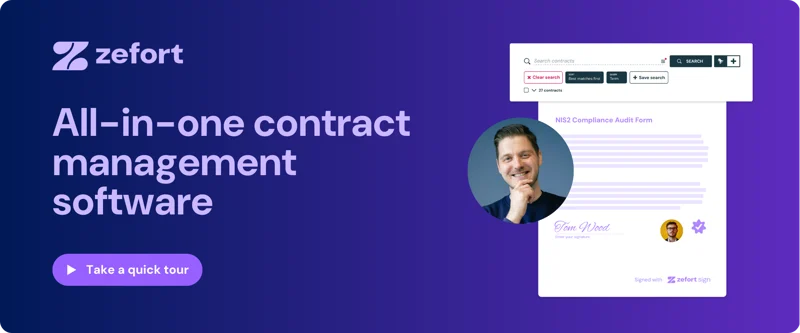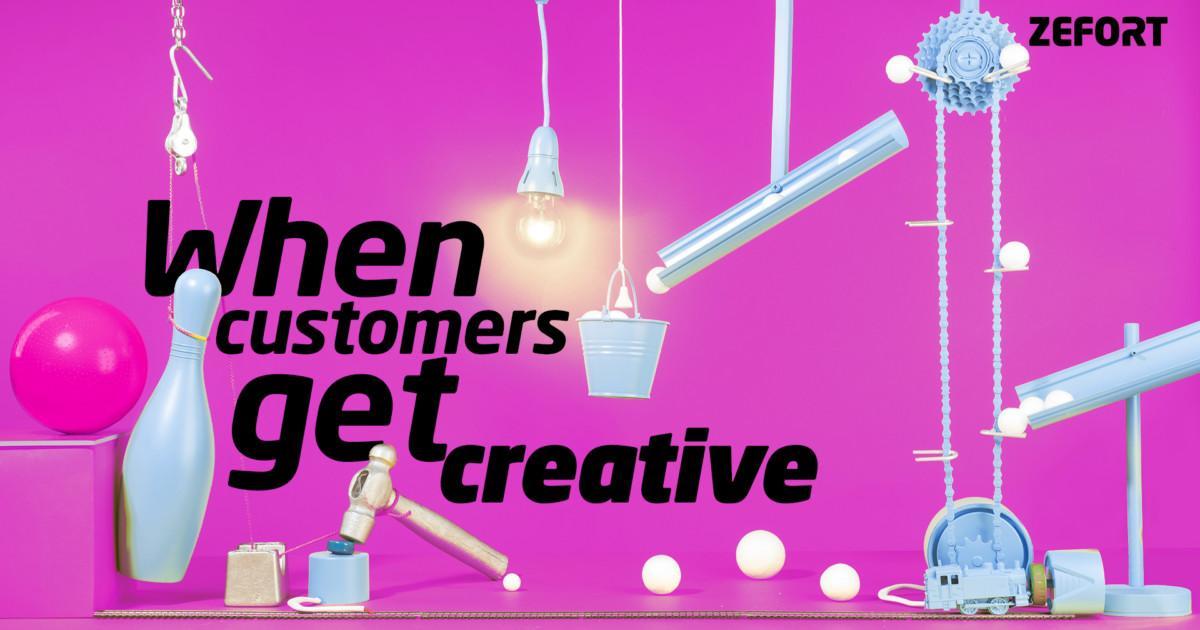Procurement contract management software: The ultimate guide
Procurement teams in 2026 operate in a landscape of tight budgets, complex supplier networks and increasingly strict regulatory demands. Every vendor agreement carries financial, legal and operational implications – from pricing and risk allocation to cybersecurity obligations under the EU’s NIS2 directive.
In many organizations, however, contracts are scattered across folders, shared drives and email attachments. Renewal dates go unnoticed, ownership is unclear and audits require days of manual collection.
Modern procurement contract management software changes that. It gives teams a single, reliable view of all supplier relationships – structured, searchable and secure.
Procurement’s new reality
Procurement is no longer only about sourcing and pricing. It’s about governance, risk and accountability. Boards expect procurement to demonstrate transparency, comply with regulations such as NIS2, and manage third-party risk proactively.
A well-designed contract management system is the backbone of that governance. It turns documents into structured data, ensures traceability and allows procurement to make decisions based on facts rather than assumptions.
What is procurement contract management software
Procurement contract management software, often called CLM (Contract Lifecycle Management), is a digital platform for storing, managing and tracking supplier agreements.
Unlike legal-first CLMs that focus on drafting and negotiation, procurement-focused systems emphasize visibility, renewals, supplier data and compliance. They provide a single environment for all vendor documents, reminders, and audit evidence.
Key outcomes include:
- Faster access to supplier agreements and terms
- Automatic tracking of renewals and milestones
- Easier collaboration with legal and finance
- Reliable documentation for audits and regulatory reviews
See also: Top 10 contract management softwares in 2026
The business case for visibility
Every procurement decision – renewing a vendor, negotiating price, approving spend – depends on contract data. When data is fragmented, decision-making slows down and compliance risk increases. Visibility creates control.
A centralized repository allows teams to search by supplier, clause or renewal date and immediately understand their exposure and commitments. Financial planning becomes more predictable, and supplier performance can be tracked with confidence.
Example:
Instead of relying on an Excel file for renewal tracking, procurement can open a dashboard showing all contracts expiring within 90 days, including responsible owners and related purchase orders.
Learn more: How to automate vendor contract renewals
Common challenges in procurement contract management
Most procurement teams face recurring challenges:
- Contracts spread across multiple tools or departments
- Renewal and expiry dates tracked manually
- Incomplete audit documentation
- Overlapping work between procurement and legal
- Unclear ownership for follow-up actions
These issues cost time, create compliance gaps and weaken procurement’s credibility as a risk-aware function.
Learn more: 5 ways to improve procurement contract management in 2026
Core capabilities of modern procurement CLM
A modern CLM platform replaces scattered files with a structured, transparent system. The most important capabilities include:
- Centralized repository
All supplier contracts are stored securely in one searchable environment accessible to procurement, legal and finance. - AI-driven structure and custom metadata
AI features automatically identify key details – supplier names, renewal dates, values, obligations – and store them as custom metadata for search and reporting. - Automated reminders and lifecycle visibility
Renewal dates, review periods and key milestones trigger automatic notifications to the right people. - Access control and audit trail
Each user’s permissions are defined by role, and every action is logged for traceability. - Supplier data forms
Procurement can collect compliance statements, ESG data or NIS2-related documentation through secure digital forms linked directly to each contract. - ERP and sourcing integrations
CLM connects seamlessly to ERP or procurement systems, ensuring contract and financial data stay synchronized. - Dashboards and analytics
Real-time metrics reveal supplier exposure, renewal timelines and contract value distribution.
Explore related insight: How AI is changing procurement contract management
See also: Audit-ready procurement contract management
Compliance under NIS2
The NIS2 directive extends cybersecurity and operational risk obligations across supply chains. It requires organizations – including many in manufacturing, energy, logistics and public services – to prove control over third-party relationships and information handling.
For procurement, this means:
- Knowing which suppliers handle critical data or infrastructure
- Ensuring contracts define clear security and notification obligations
- Maintaining audit trails and evidence of compliance
- Being able to demonstrate due diligence during inspections
A procurement CLM built with compliance in mind makes this straightforward. Each supplier contract is stored with its metadata, risk level, owner and documentation – and every update is tracked automatically. When regulators or auditors request proof, procurement can provide it instantly.
Zefort aligns with this need by combining secure storage, automated audit trails and supplier data collection (via Zefort Forms) in one environment.
Read more: How to audit suppliers easily with Zefort Forms
Collaboration across departments
Procurement rarely works alone. Every vendor agreement touches legal, finance and operations. A shared contract platform removes the friction between teams:
- Legal approves and archives agreements directly in the system.
- Finance links contracts to payment terms and budgets.
- Procurement monitors renewals and performance.
This cross-functional transparency eliminates duplicate work and ensures everyone operates with the same verified information.
Evaluating CLM software for procurement
When comparing solutions, focus on features that deliver both efficiency and adoption value:
- Centralized, searchable archive
- Automated AI metadata and reminders
- Configurable user permissions
- Supplier compliance forms or portals
- Integration with ERP or sourcing systems
- Strong NIS2 and cybersecurity alignment
- Ease of use across departments
Checklist for procurement software evaluation
- Can we search and filter all contracts by supplier, date and risk level?
- Are reminders and audits automated or manual?
- Does the system help collect supplier compliance data?
- How easily can non-technical users adopt it?
- Is the platform designed for NIS2 compliance reporting?
Compare systems: Zefort vs other CLM solutions for procurement teams
Why procurement teams choose Zefort
Zefort offers a full contract lifecycle management solution designed specifically for procurement.
It combines intuitive design with enterprise-grade governance:
- A secure, centralized hub for all vendor contracts
- AI-driven organization of key contract data
- Automated reminders and lifecycle tracking
- Supplier audit and compliance forms built in
- Integration with SAP, Visma, MS Dynamics and other ERP systems
- NIS2-ready data protection and transparent audit trail
Procurement, legal and finance share the same source of truth – and the same confidence that every supplier relationship is documented and compliant.
CLM implementation roadmap
You can implement a centralized contract management system step by step:
Step 1: Collect active supplier contracts
Start with the most critical categories or vendors.
Step 2: Standardize metadata
Define mandatory fields such as supplier name, renewal date, owner and NIS2 relevance.
Step 3: Set automated reminders
Create rule-based alerts for renewals, reviews and compliance checks.
Step 4: Introduce supplier forms
Collect compliance and security documentation directly from vendors.
Step 5: Review and expand
Gradually include new contract types and departments until all vendor agreements are visible and traceable.
Within weeks, procurement gains measurable time savings and confidence that no contract or supplier slips through the cracks.
Procurement CLM trends to watch in 2026
- AI-assisted reporting for supplier risk and performance
- Integration between CLM and sustainability tracking (ESG and Scope 3 data)
- Growing influence of NIS2 and cybersecurity frameworks on supplier contracts
- Unified dashboards connecting procurement, legal and compliance metrics
- Simplified user experiences to drive adoption across large organizations
Procurement teams that invest now in structured, compliant contract data will have a clear advantage as regulations tighten and digital transparency becomes the norm.
🔑 Key takeaways
- Visibility, automation and NIS2 compliance define modern procurement success.
- Centralized CLM systems eliminate manual tracking and fragmented data.
- AI and supplier forms transform contract archives into living, audit-ready information
- Collaboration across procurement, legal and finance improves governance and efficiency.
- Zefort delivers these capabilities in one intuitive, secure platform.
Let’s talk about your procurement needs
Every procurement organization has different priorities – from renewal control and audit readiness to AI visibility and supplier compliance. Zefort’s team helps you evaluate what matters most and shows exactly how those needs translate into your contract workflows.
Talk to our experts to see how Zefort compares to your current system and what a transition could look like for your team.
Book a 30-minute discussion with Zefort or click below to take a self-guided tour of the solution.
FAQs
Procurement contract management software is a digital platform that helps procurement teams store, organize and manage supplier agreements in one secure location. The software tracks key dates, approvals and obligations, giving full visibility across the vendor base.
NIS2 requires organizations to demonstrate control over suppliers that affect their cybersecurity and operational continuity. A procurement CLM system supports compliance by maintaining structured records, audit trails and supplier documentation that prove due diligence.
AI automates repetitive work such as identifying suppliers, renewal dates and contract owners. It creates custom metadata that makes reporting and search instant, improving accuracy and freeing time for higher-value tasks.
Digital forms let procurement collect supplier declarations, for example, ESG or NIS2-related data, in a consistent, verifiable way. Each submission is automatically stored with the relevant contract, creating a complete audit trail.
Zefort combines ease of use with strong compliance features. It provides a centralized contract hub, AI-driven structure, automated reminders and supplier forms, which are built on a secure, NIS2-ready architecture.





